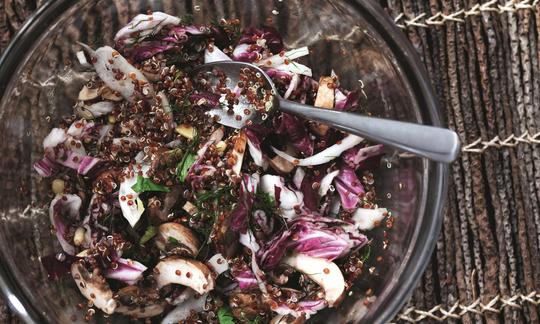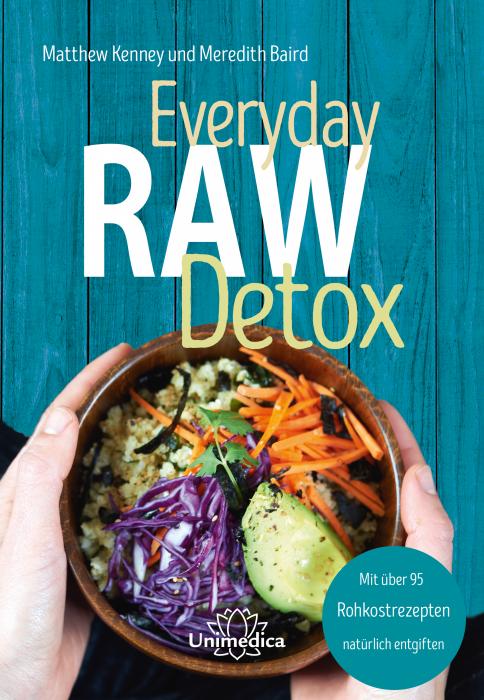Black Fall Quinoa with Radicchio, Fennel, and Mushrooms
vegan
Ingredients (for servings, )
| For the quinoa | |
|---|---|
| 2 ½ oz | Quinoa, raw, peeled (organic?) |
| 140 ml | Drinking water, raw (organic?) (4.9 oz) |
| For the mushrooms | |
| 5 ½ oz | Cultivated mushrooms, raw (organic?) |
| ½ tbsp | Reduced salt soy sauce (Genen-Shoyu, organic?, raw?) (0.28 oz) |
| ½ tbsp | Olive oil (cold pressed, raw?, organic?) (0.24 oz) |
| Assembly | |
| 1 | Radicchio, raw (organic?) (9.4 oz) |
| 1 | Fennel (bulb, raw, organic?) (10 oz) |
| 2 tbsp | Parsley, fresh, raw (leaf parsley, parsley) (0.27 oz) |
| 2 tbsp | Pine nuts, raw (seeds, organic?) (0.48 oz) |
| 1 | Lemons, raw (limes, organic?) (2.0 oz) |
| 1 tbsp | Olive oil (cold pressed, raw?, organic?) (0.47 oz) |
| ½ tsp | Sea salt (raw?, organic?) (0.09 oz) |
| 1 dash | Black pepper (organic?, raw?) (0.00 oz) |
Equipment
- stove
- citrus juicer (lemon squeezer)
- saucepan
- sieve
Type of preparation
- cook
- chop or grind
- squeeze
- meld
Preparation
For the quinoa
Rinse the quinoa under running water in a sieve. Transfer to a saucepan, add the water, and bring to a boil. Reduce the heat and let simmer for 15 minutes. Then pour off any remaining water.Matthew Kenney recommends using black quinoa.
For the mushrooms
Clean the mushrooms and cut into thin slices. Marinate mushrooms with tamari and oil for approximately 10 minutes.The original recipe calls for cremini mushrooms.
We use a low-salt variety soy sauce called genen shoyu whereas the original recipe calls for the gluten-free soy sauce tamari.
Assembly
Clean the radicchio and cut both the radicchio and fennel into thin slices. Finely chop the parsley and then add to the radicchio and fennel.Squeeze the juice from the lemon and add to the vegetable mixture along with the olive oil, sea salt, and freshly ground black pepper.
Serving
While quinoa is still warm, toss all ingredients together. Allow to marinate for at least 10 minutes before serving so that the flavors can combine.This recipe makes 2–4 servings, depending on whether you are serving it as a side or main dish.
|
Nutritional Information per person
Convert per 100g
|
2000 kcal | |
|---|---|---|
| Energy | 324 kcal | 16.2% |
| Fat/Lipids | 17 g | 24.4% |
| Saturated Fats | 2.2 g | 10.8% |
| Carbohydrates (inc.dietary fiber) | 38 g | 14.0% |
| Sugars | 9.7 g | 10.7% |
| Fiber | 9.5 g | 38.2% |
| Protein/Albumin | 11 g | 21.6% |
| Cooking Salt (Na:719.6 mg) | 1'828 mg | 76.2% |
| Essential micronutrients with the highest proportions | per person | 2000 kcal | |
|---|---|---|---|
| Vit | Vitamin K | 458 µg | 611.0% |
| Min | Copper, Cu | 1.0 mg | 104.0% |
| Sodium, Na | 720 mg | 90.0% | |
| Vit | Vitamin B9, B11 (Folate, as the active form of folic acid) | 172 µg | 86.0% |
| Min | Manganese, Mn | 1.6 mg | 78.0% |
| Elem | Potassium, K | 1'457 mg | 73.0% |
| Vit | Vitamin C (ascorbic acid) | 50 mg | 62.0% |
| Vit | Vitamin E, as a-TEs | 6.5 mg | 54.0% |
| Elem | Phosphorus, P | 342 mg | 49.0% |
| Prot | Tryptophan (Trp, W) | 0.11 g | 43.0% |
Detailed Nutritional Information per Person for this Recipe
The majority of the nutritional information comes from the USDA (US Department of Agriculture). This means that the information for natural products is often incomplete or only given within broader categories, whereas in most cases products made from these have more complete information displayed.
If we take flaxseed, for example, the important essential amino acid ALA (omega-3) is only included in an overarching category whereas for flaxseed oil ALA is listed specifically. In time, we will be able to change this, but it will require a lot of work. An “i” appears behind ingredients that have been adjusted and an explanation appears when you hover over this symbol.
For Erb Muesli, the original calculations resulted in 48 % of the daily requirement of ALA — but with the correction, we see that the muesli actually covers >100 % of the necessary recommendation for the omega-3 fatty acid ALA. Our goal is to eventually be able to compare the nutritional value of our recipes with those that are used in conventional western lifestyles.
| Essential fatty acids | per person | 2000 kcal |
|---|---|---|
| Linoleic acid; LA; 18:2 omega-6 | 3.7 g | 37.0% |
| Alpha-Linolenic acid; ALA; 18:3 omega-3 | 0.17 g | 9.0% |
| Essential amino acids | per person | 2000 kcal |
|---|---|---|
| Tryptophan (Trp, W) | 0.11 g | 43.0% |
| Valin (Val, V) | 0.44 g | 28.0% |
| Threonine (Thr, T, irreversibly transaminated) | 0.26 g | 27.0% |
| Isoleucine (Ile, I) | 0.32 g | 26.0% |
| Lysine (Lys, K, irreversibly transaminated) | 0.37 g | 20.0% |
| Leucine (Leu, L) | 0.43 g | 18.0% |
| Phenylalanine (Phe, F) | 0.28 g | 18.0% |
| Methionine (Met, M) | 0.12 g | 13.0% |
| Vitamins | per person | 2000 kcal |
|---|---|---|
| Vitamin K | 458 µg | 611.0% |
| Vitamin B9, B11 (Folate, as the active form of folic acid) | 172 µg | 86.0% |
| Vitamin C (ascorbic acid) | 50 mg | 62.0% |
| Vitamin E, as a-TEs | 6.5 mg | 54.0% |
| Vitamin B2 (Riboflavin) | 0.49 mg | 35.0% |
| Vitamin B5 (Pantothenic acid) | 1.9 mg | 32.0% |
| Vitamin B3 (Niacin) | 4.6 mg | 29.0% |
| Vitamin B7 (Biotin, ex vitamin H) | 13 µg | 26.0% |
| Vitamin B6 (pyridoxine) | 0.34 mg | 24.0% |
| Vitamin B1 (Thiamine) | 0.21 mg | 19.0% |
| Vitamin A, as RAE | 86 µg | 11.0% |
| Vitamin D | 0.15 µg | 3.0% |
| Vitamin B12 (Cobalamin) | 0.03 µg | 1.0% |
| Essential macroelements (macronutrients) | per person | 2000 kcal |
|---|---|---|
| Sodium, Na | 720 mg | 90.0% |
| Potassium, K | 1'457 mg | 73.0% |
| Phosphorus, P | 342 mg | 49.0% |
| Magnesium, Mg | 116 mg | 31.0% |
| Calcium, Ca | 127 mg | 16.0% |
| Essential trace elements (micronutrients) | per person | 2000 kcal |
|---|---|---|
| Copper, Cu | 1.0 mg | 104.0% |
| Manganese, Mn | 1.6 mg | 78.0% |
| Iron, Fe | 4.1 mg | 29.0% |
| Zinc, Zn | 2.8 mg | 28.0% |
| Selenium, Se | 11 µg | 21.0% |
| Iod, I (Jod, J) | 15 µg | 10.0% |
| Fluorine, F | 56 µg | 2.0% |
Narayana Verlag GmbH /Unimedica Verlag , Matthew Kenney
Raw recipes 72 (1), Cooked recipes 18 (2)
Additional photos (8)
In his book "Everyday Raw Detox," Matthew Kenney presents many innovative and creative raw food recipes designed to help detoxify our bodies.
Since this book is written in German, a description is omitted here. If you are interested, please switch to German in the menu.
With its sharp, bitter, and intense flavor, radicchio doesn’t only complement fennel and mushrooms, it also provides many valuable nutrients — as does quinoa.
Quinoa: Quinoa is a pseudograin that originated in the South American Andes. The quinoa sold commercially has had the bitter coating called saponin removed. Quinoa is available in a number of different varieties and colors. White quinoa has a light texture when cooked whereas red quinoa has a somewhat richer taste and holds its shape better. Black quinoa holds its shape the best and has an earthy, slightly sweet flavor. It is best to wash quinoa before cooking to remove any remaining traces of the bitter saponin. Quinoa is gluten-free and contains more protein, magnesium, and iron than the other common types of grains. It also contains all of the essential amino acids, including lysine!
Mushrooms: White button mushrooms are the most common type of cultivated mushrooms. They are firm and have a mild flavor. You can eat button mushrooms cooked, fried, and also raw — for example, in salads. Cremini mushrooms are a special variety that is even firmer than white mushrooms and hold up better in sauces and soups. They also have a fuller taste. Unlike wild mushrooms, cultivated mushrooms are sold year-round in grocery stores and markets.
Fennel: Fennel originated in the Mediterranean region and Asia Minor, and both the bulb and seeds are used as an ingredient in raw and cooked dishes. IFennel is in the Apiaceae or Umbelliferae family, as is celery. The white to light-green bulb is composed of several layers and therefore has a similar structure to that of the onion. Fennel has an intense flavor that is a result of the high amounts of essential oils it contains. The essential oils have many health-promoting properties. For example, they support digestion, are thought to inhibit inflammation, and strengthen the stomach. Fennel bulbs have green tops that are reminiscent of dill.
Reducing sugar and salt: For health reasons, we have deliberately reduced the amount of salt and oil. You can read more about this topic in our in-depth review of the book Salt Sugar Fat by Michael Moss. The reason the salt content is still too high is because of the soy sauce, which contains 5–6 % sodium.
Cleaning mushrooms: It works best to clean mushrooms dry using a brush. If there is a lot of visible dirt, you can wash them under running water. Never wash mushrooms in standing water as they absorb water quickly. Don’t store mushrooms at high temperature or in a damp place as this will cause them to spoil more quickly.
Varieties of quinoa: Instead of black quinoa, you can also use red or white quinoa. Don’t let it cook too long or it will get mushy.
When you need to save time: If you are in a hurry, you can also use precooked quinoa. For this recipe for 2–4 servings, you would need 200 g.




